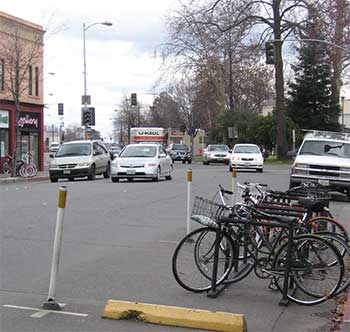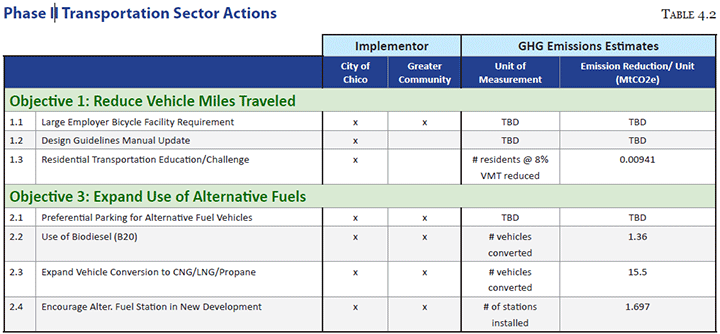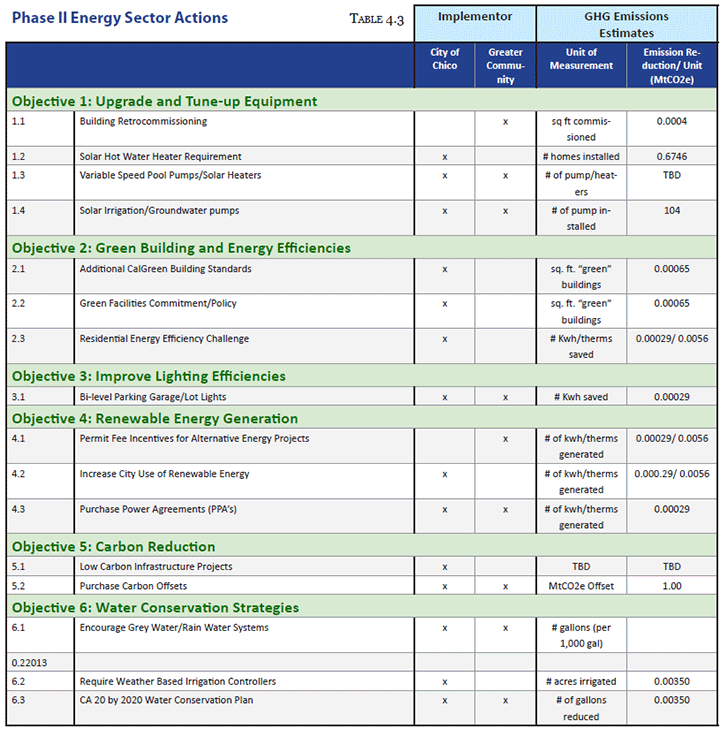The CAP includes 27 Phase II actions described below and depicted in Tables 4.2 through 4.5 for each sector: Transportation, Energy, and Solid Waste.
There are fewer actions in Phase II than Phase I because many of the Phase I actions will still reduce emissions during Phase II and because the list of Phase II actions will be reviewed and likely expanded before Phase II begins. For many of the reasons stated above, the GHG emissions reductions for these potential actions have not been quantified at this time, but will be estimated if and when chosen for implementation during Phase II.
Transportation Sector Actions
Objective 1: Reduce Vehicle Miles Traveled
1.1 Require Large Employers to Provide Facilities to Encourage Bicycle Commuting
 A large barrier to cycling as a means of commuting to work is a lack of facilities for changing into work clothes and protecting bicycles from the rain. Shower facilities encourage people who live further away to cycle to work. Covered and indoor bicycle parking increase security and prevent bikes from getting wet during the winter. The new action will establish a standard for large employers to provide showers and covered bicycle storage facilities where feasible.
A large barrier to cycling as a means of commuting to work is a lack of facilities for changing into work clothes and protecting bicycles from the rain. Shower facilities encourage people who live further away to cycle to work. Covered and indoor bicycle parking increase security and prevent bikes from getting wet during the winter. The new action will establish a standard for large employers to provide showers and covered bicycle storage facilities where feasible.
1.2 Design Guidelines Manual Update
With direction from the 2030 General Plan, the City will amend its Design Guidelines Manual to address residential infill conflicts, detail how to incorporate passive solar design into buildings, and include provisions for remaking older auto-centric transit corridors as pedestrian-friendly, multi-modal seams within the community. Renewed corridors support infill and redevelopment, and promote non-auto transportation modes. Passive solar design solutions support energy efficiency and renewable energy. The reductions from this action are not quantified to avoid possible double-counting with other quantified actions related to infill development and solar photovoltaic installations.
1.3 Residential Transportation Education and Challenge:
The City will partner with BCAG to expand its public education and outreach campaigns to encourage residents to use alternative transportation and reduce their individual annual vehicle miles traveled by 8%. The amount of GHG emissions reductions from this challenge will be determined in the future based on the number of participants who obtain this goal and the vehicle miles saved.
Objective 2: Expand the Use of Alternative Fuels
2.1 Preferential Street Parking for Alternative fueled vehicles
The City will provide preferential parking spaces for car share, carpool, and ultra-low or zero emission vehicles such as electric vehicles that will encourage residents to carpool or purchase low or zero emission vehicles. Preferential street parking spaces for eligible vehicle types will be located throughout the community’s commercial districts.
2.2 Use of Biodiesel
Biodiesel is alternative diesel fuel derived from biological sources, which can be used in unmodified diesel-engine vehicles. If readily available locally and if it does not impact local food resources, the City will convert a portion of its fleet to use B20 biodiesel (80% diesel/20% biodiesel),
2.3 Expand Conversions to Compressed or Liquid Natural Gas (CNG or LNG) or Propane
The City will continue to pursue converting the City’s equipment and vehicles to those that use CNG, LNG or propane where possible. The City will also continue to encourage BCAG, the solid waste haulers, and other local diesel fleets to consider converting their vehicles to CNG or LNG where feasible.
2.4 Encourage Alternative Fuel Stations in Certain New Development
The City will require that master plans and planned developments projects in new growth areas include the siting of alternative fueling stations and electrical vehicle charging stations.
The following Table 4.2 lists potential Phase II Transportation Sector actions, identifies the anticipated implementer (City of Chico or the greater community), and provides the unit of measurement and emission factors that will be used to calculate the annual 2020 GHG emissions reductions for each action (if available).

Energy Sector Actions

Objective 1: Upgrade and Tune-Up Equipment
1.1 Building Commissioning and Retrocommishing
Before 2005, several City buildings received energy audits and lighting upgrades to improve their energy efficiency. Based on the results of further energy audits of City facilities, the City will continue to prioritize and complete energy efficiency upgrades on its municipal buildings, where feasible.
1.2 Encourage Solar Hot Water Heaters in New Development
Solar hot water systems offer a simple and reliable way to harness the sun’s energy to provide hot water. The City will work with PG&E and other agencies to promote financial incentives for the installation of solar hot water systems. In addition, the City may amend the Municipal Code to require certain new residential and commercial development projects to install solar hot water systems.
1.3 Variable Speed Pool Pumps and Solar Water Heating Systems for Swimming Pools
Swimming pools can account for up to 20% of a residence’s energy consumption. Through an education and outreach campaign, the City will encourage residents to install variable speed swimming pool pumps and solar water heating systems. In Phase II, the City will amend the Municipal Code to require variable speed pumps and solar water heating systems in new swimming pools, where applicable.
1.4 Solar Irrigation and Groundwater Pumps
The City will work with Cal Water, the Chico Area Recreation District, and other public agencies to determine whether irrigation and groundwater pumps can be converted to use solar generated electricity or other alternative energy sources.
Objective 2: Green Building and Energy Efficiencies
2.1 Consider Adoption of Additional Building Standards for Energy Efficiency
The City will consider amending the Chico Muncipal Code to require and verify that all new construction exceed the Title 24 energy efficiency requirements by 15% by 2020 ( Tier 1 Standard).
2.2 City of Chico Green Facilities Commitment
Consistent with the General Plan, new significant City facilities will be constructed to achieve at least the Silver baseline certification level of Leadership in Energy and Environmental Design (LEED), or equivalent.
2.3 Residential Energy Efficiency Challenge
The City will partner with PG&E to expand its public education and outreach campaigns to promote energy efficiency improvements within the community, including information on rebates and incentives. An energy efficiency challenge is also an effective way to motivate people to save energy. The City will challenge residents to reduce their energy use by 10%. The amount of GHG emissions reductions from this challenge will be determined in the future based on the number of participants who obtain this goal.
Objective 3: Improve Lighting Efficiencies
3.1 Encourage/Require Bi-Level Parking Lot/ Structure Lights
Many parking garage structures or parking lots in commercial and institutional facilities are currently illuminated with high pressure sodium and metal Halide ceiling mounted fixtures. Because it is common for parking lots and garages to have lights on all day or all night, regardless of the occupancy or lighting need, these facilities are excellent candidates for an upgrade to bi-level lighting. Bi-level fixtures, such as induction, ceramic metal halide, and LED, which are also controlled by motion sensors, present an opportunity to use 30- 75% less energy by dimming light levels when parking areas are unoccupied. Bi-level lighting controls can also turn off perimeter light fixtures for much of the day in areas that receive sufficient daylight to meet lighting needs.
As funding allows, the City will convert its existing parking garage and parking lots to use these bi-level lights. Through the PACE program identified in Phase I, the City will also encourage the retrofit of lighting for existing large parking lots and garages, such as at the Chico Mall and Enloe Hospital, and will require the use of these fixtures in new large commercial and industrial developments.
Objective 4: Renewable Energy Generation
4.1 Building Fee Incentives for Alternative Energy Installations (Solar/Wind)
When economic conditions are more favorable , the City will consider reducing or waiving building permit and/or plan review fees for photovoltaic solar or other renewable energy systems on existing residential and commercial buildings. This type of financial incentive encourages the proliferation of solar projects and is consistent with a number of initiatives at the local, State and Federal level.
4.2 Increase the City’s Municipal Use of Renewable Energy
The City will investigate the potential to increase its purchase of renewable energy sources for it’s municipal buildings and facilities by at least 10% above the PG&E’s 33% renewable grid mix required under the AB32 Scoping Plan.
4.3 Power Purchase Agreements
Renewable energy has become increasingly more accessible and cost-effective due to Power Purchase Agreements (PPAs). In a PPA, a private company or third party installs a renewable energy technology, often solar panels, at no cost to the consumer and maintains ownership of the installed panels, selling customers the power produced on a per kilowatt-hour basis at a contractually established rate. The rate is often lower than what customers pay to PG&E, and the rate increases at a fixed percentage annually. In addition to installing the panels, the third party owns, monitors, and maintains the systems to ensure that they keep working. These agreements are ideal for either projects implemented by the City, or for residents or businesses with interests in reducing the energy consumptions in their homes and businesses. The City will pursue the installation of renewable energy projects on City property at the Chico Municpal Airport Industrial Area and may offer this renewable energy source and incentive to commercial and industrial businesses located within this industrial area.
Objective 5: Carbon Reduction
5.1 Low Carbon Projects
 The City will develop a policy encouraging the implementation and construction of low carbon impact public works and infrastructure projects. This will include reducing transportation needs during construction, reducing waste, reusing asphalt and other materials, and other activities to reduce GHG emissions generated from projects constructed by the City directly, or through its contractors.
The City will develop a policy encouraging the implementation and construction of low carbon impact public works and infrastructure projects. This will include reducing transportation needs during construction, reducing waste, reusing asphalt and other materials, and other activities to reduce GHG emissions generated from projects constructed by the City directly, or through its contractors.
5.2 Purchase Carbon Offsets
To help meet its 2030 overall greenhouse gas reduction goal, the City will explore investing in carbon offsets and retiring the associated credits. The City could also encourage residents, businesses, governments, schools, and institutions to invest in greenhouse gas-reducing projects to offset their personal or corporate greenhouse gas emissions. In addition, the City will explore ways to create offset programs which provide revenues for local climate change projects, such as development impact fees, requiring offsite tree planting, or other measures to offset project-related emissions.
Objective 6: Water Conservation
6.1 Encourage the use of Grey Water and Rainwater Systems
Grey water systems save water by reusing untreated household wastewater from bathtubs, showers, bathroom washbasins, and clothes washing machines. Rainwater may be collected from roofs and other impermeable surfaces and stored in cisterns or barrels for use in dry weather sub-surface or surface irrigation. Current California law permits use of grey water systems for subsurface irrigation if compliant with Title 24, Part 5 of the California Plumbing Code. In 2008, the adoption of Senate Bill 1258 made grey water systems more feasible in the California. The City will provide information to residents and businesses about the opportunities to construct such systems on their properties, and may require grey water systems where appropriate for new development.
6.2 Require Weather-based Irrigation Controllers
The City will require the use of weather-based, Evapotranspiration (ET) controllers for new development and landscape projects over 2,500 square feet. This action is estimated to achieve 0.2201 MtCO2e of GHG emissions reductions for each acre irrigated by these controllers.
6.3 California 20 x 2020 Water Conservation Plan
In February 2008, a comprehensive program was introduced to reduce statewide per capita urban water use by 20% by the year 2020. The 20 x 2020 Water Conservation Plan requires that Chico’s local water purveyor, Cal Water, through a series of strategies, programs, incentives, and enforcement achieve the 20% per capita reduction. Benefits associated with this significant reduction in water use include a commensurate reduction in energy use for pumping, treating, and storage of water.
The following Table 4.3 lists potential Phase II Energy Sector actions, identifies the anticipated implementer (City of Chico or the greater community), and provides the unit of measurement and emission factors that will be used to calculate the annual 2020 GHG emissions reductions for each action (if available).

Solid Waste Sector Actions
Objective 1: Expand Recycling Efforts
1.1 City Waste Policy
The City will consider establishing a waste-reduction program for municipal operations by designing and managing goods and products to allow for the reduction, reuse, and recycling of waste, where feasible. Specifically, the City would establish a detailed recycling, composting, and Staff education program that would establish a goal that on a per capita basis that at least 75% of materials are reused, recycled, or composted.
1.2 Increase Construction and Demolition (C&D) Recycling
If feasible and if local recycling opportunities are available, the City will amend the Chico Muncipal Code to require all new construction to exceed the CALGreen 50% C&D waste diversion requirement by 25% to achieve a 75% diversion rate by 2020.
Objective 2: Expand Composting Efforts
2.1 Composting of Food Waste
Currently, the City’s compost facility does not have the capacity nor is it permitted to compost food waste. The City will work with the local waste haulers, Butte County, and other agencies to develop a facility or program to compost food waste from commercial and residential sectors.
Solid Waste Objective 3: Renewable Energy Generation
3.1 Expand Landfill Methane Capture
During Phase I, Butte County began capturing methane out of the landfill that was estimated to generate up to 2.2 megawatts. The County intends to expand the methane capture program, which is estimated to generate up to 4.3 megawatts per year.
The following Table 4.4 lists potential Phase II Energy Sector actions, identifies the anticipated implementer (City of Chico or the greater community), and provides the unit of measurement and emission factors that will be used to calculate the annual 2020 GHG emissions reductions for each action (if available).



